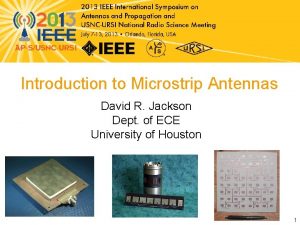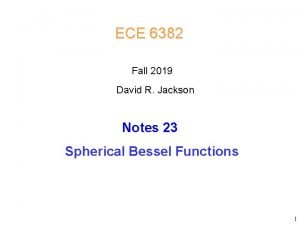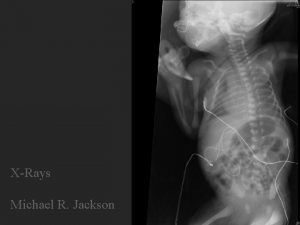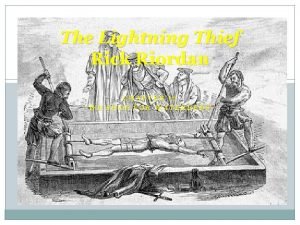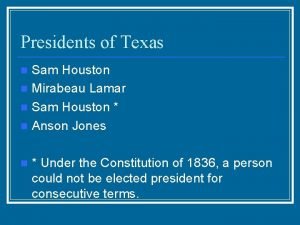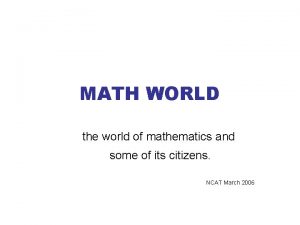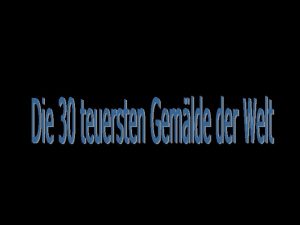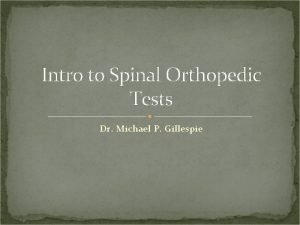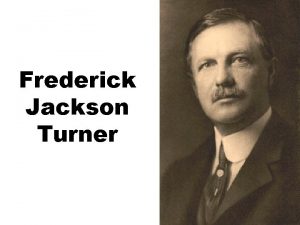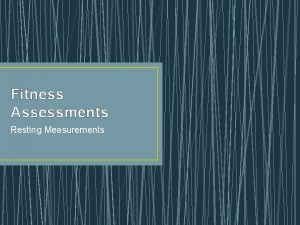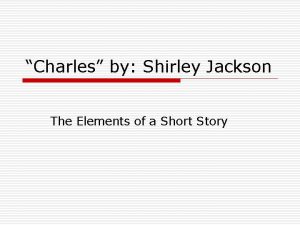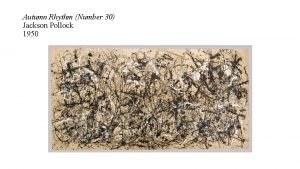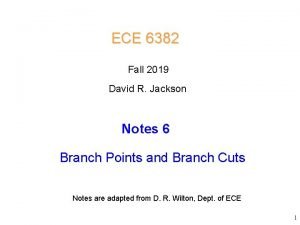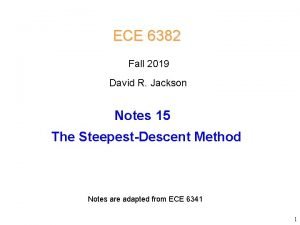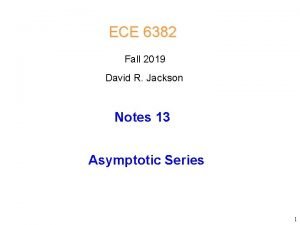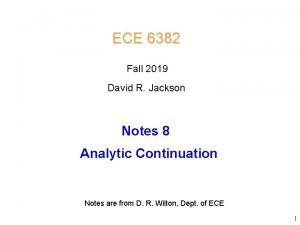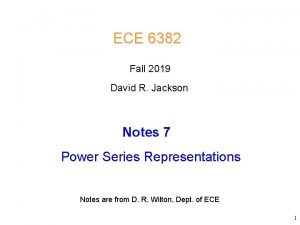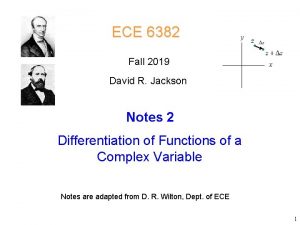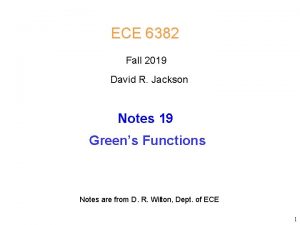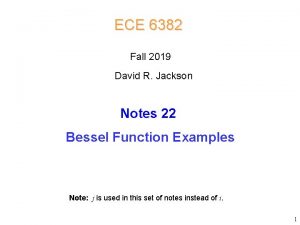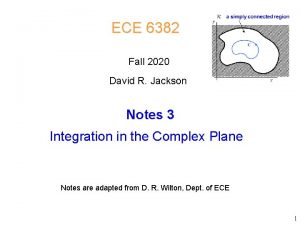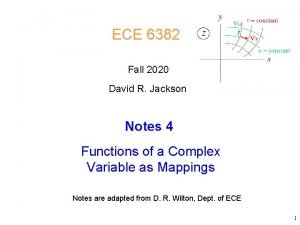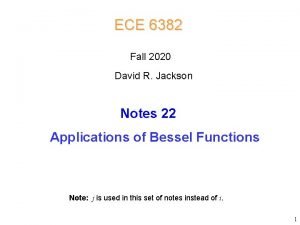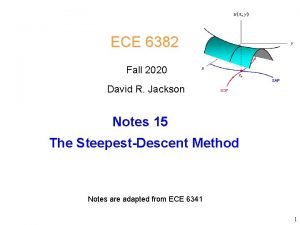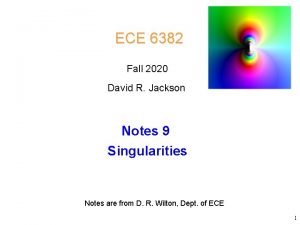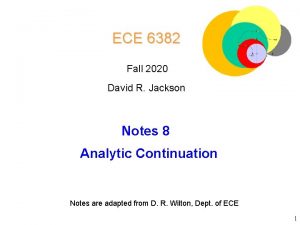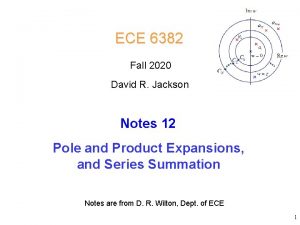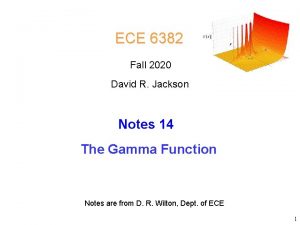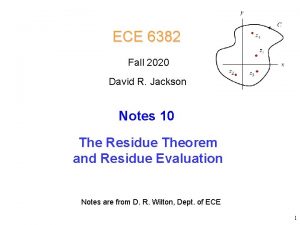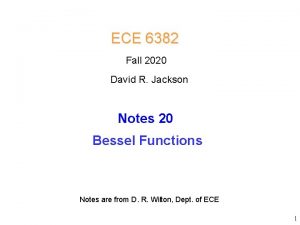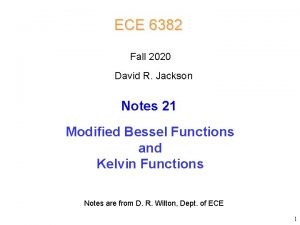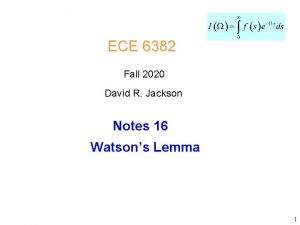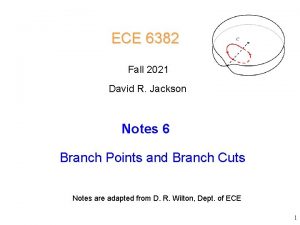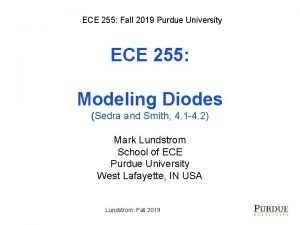ECE 6382 Fall 2019 David R Jackson Notes

























































- Slides: 57

ECE 6382 Fall 2019 David R. Jackson Notes 5 Conformal Mapping Notes are adapted from D. R. Wilton, Dept. of ECE 1

Conformal Mapping This is a method for solving 2 D problems involving Laplace’s equation. or J. W. Brown and R. V. Churchill, Complex Variables and Applications, 9 th Ed. , Mc. Graw-Hill, 2013. 2

Conformal Mapping (cont. ) The function f (z) is assumed to be analytic in the region of interest. C z plane A complicated boundary in the z plane is mapped into a simple one in the w plane -- for which we know how to solve the Laplace equation. w plane Desired Final Result: Known 3

Conformal Mapping (cont. ) The key to being successful with the method of conformal mapping is to find a mapping that works for your problem (i. e. , it maps your problem into one the is simple enough for you to solve). v J. W. Brown and R. V. Churchill, Complex Variables and Applications, 9 th Ed. , Mc. Graw-Hill, 2013. Ø An appendix has many basic conformal mappings. v H. Kober, Dictionary of Conformal Representations, Admiralty, Mathematical and Statistical Section, Dept. of Physical Research, 1945. Ø A very thorough compilation of conformal mappings. 4

Conformal Mapping (cont. ) Theorem: If (u, v) satisfies the Laplace equation in the (u, v) plane, then (x, y) satisfies the Laplace equation in the (x, y) plane. Proof: Assume that or We want to prove that 5

Conformal Mapping (cont. ) Using the chain rule: 6

Conformal Mapping (cont. ) Using the chain rule: 7

Conformal Mapping (cont. ) Use Cauchy-Riemann equations (red, blue, and black terms): satisfies Laplace’s equation. 8

Conformal Mapping (cont. ) Recall that for any analytic function f Hence, we have (proof complete) 9

Conformal Mapping (cont. ) Theorem that u and v are harmonic functions (revisited) Choose so that Note: The mapping function is arbitrary here, but it is assumed to be analytic. Clearly, in either case we have Hence, from our theorem, we have The functions u and v, the real and imaginary parts of an analytic function, satisfy Laplace’s equation (as we proved previously in Notes 2). 10

Conformal Mapping (cont. ) Example (This satisfies Laplace’s equation. ) Assume: (This is an analytic mapping function. ) This must satisfy Laplace’s equation. 11

Conformal Mapping (cont. ) Example Assume: (This satisfies Laplace’s equation. ) (This is an analytic mapping function. ) so This must satisfy Laplace’s equation. 12

Conformal Mapping (cont. ) Theorem: If (u, v) satisfies Dirichlet or Neumann boundary conditions in the (u, v) plane, then (x, y) satisfies the same boundary conditions in the (x, y) plane. Proof: Assume that Then we immediately have that since 13

Conformal Mapping (cont. ) Next, assume that Because of the angle-preserving (conformal) property of analytic functions, we have: 14

Conformal Mapping (cont. ) Relation Between Charge Densities in the Two Planes so 15

Conformal Mapping (cont. ) Hence, we have 16

Conformal Mapping (cont. ) Theorem: The capacitance (per unit length) between two conductive objects remains unchanged between the z and w planes. Proof: (same in both planes) 17

Conformal Mapping (cont. ) Therefore, 18

Conformal Mapping (cont. ) Relation Between Electric Field in the Two Planes Hence Note: The electric field vector in the z plane is also rotated from that in the w plane by - arg f (z 0). 19

Example Solve for the potential inside of a coax and the capacitance per unit length of a coax. 20

Example (cont. ) PMC PEC PMC 21

Example (cont. ) (no v dependence in ) Boundary conditions PMC PEC PMC 22

Example (cont. ) (In the final answer we use instead of r. ) so or 23

Example (cont. ) so PMC PEC PMC 24

Example Solve for the potential inside and outside of a semi-infinite parallel-plate capacitor. Find the surface charge density on the lower surface of the top plate. 25

Example (cont. ) 26

Example (cont. ) The corresponding colored dots show the mapping along the top plate. Note: x reaches a maximum (x = -1) at u = 0. 27

Example (cont. ) This is an ideal infinite parallel-plate capacitor, whose solution is simple: Note: The inside of the parallel-plate capacitor in the w plane gets mapped to the entire z plane. 28

Example (cont. ) The solution is: where For any given (x, y), these two equations have to be solved numerically to find (u, v). 29

Example (cont. ) The charge density in the w plane on the lower surface of the top plate is: The charge density in the z plane is: 30

Example (cont. ) Hence we have: 31

Example (cont. ) Rewriting in terms of x, we have: Choose negative sign (lower surface of top plate) 32

Example (cont. ) Hence we have: or 33

Example (cont. ) + + ++ Near the upper edge (on the lower surface) we then have: Note the square-root singularity at the edge! 34

Example Solve for the potential surrounding a metal strip, and the surface charge density on the strip. Note: The potential goes to - as . 35

Example (cont. ) The outside of the circle gets mapped into the entire z plane. (We don’t need to consider the inside of the circle, since the points w = w 0 and w = 1/w 0 get mapped to the same z point. ) 36

Example (cont. ) Outside the circle, we have (from simple electrostatic theory): Note: To be more general, we could use From electrostatics (with no variation): Changing the constant A 1 changes the total charge on the strip. Changing the constant A 2 changes the voltage on the strip. 37

Example (cont. ) Hence, we have: For any given (x, y), these two equations can be solved numerically to find (R, ). 38

Example (cont. ) Charge density on strip Note: Going normal to the strip in the z plane means going normal to the circle in the w plane. On the upper surface of the strip, we have: 39

Example (cont. ) We then have 40

Example (cont. ) Next, use so so or 41

Example (cont. ) On the circle: so 42

Example (cont. ) On the strip: so Hence, we have Note: The surface charge density goes to infinity as we approach the edges. This result was first derived by Maxwell! 43

Example (cont. ) y Here s is the distance from the edge. Knife-edge singularity x w The strip now has a width of w, and the total line charge density (sum of top and bottom line charge densities) is assumed to be l [C/m]. Note: The normalization of 1/ corresponds to a unity total line charge density: 44

Example (cont. ) Microstrip line y w h x Note: The increased current density near the edges causes increased conductor loss and susceptibility to dielectric breakdown. 45

Example Find the capacitance between two wires. Radii and offset: (from Churchill book) Hence, we have: J. W. Brown and R. V. Churchill, Complex Variables and Applications, 9 th Ed. , Mc. Graw-Hill, 2013. 46

Example (cont. ) We therefore have where 47

Example (cont. ) Symmetrical “twin lead” transmission line Scale this geometry by 1/a: x 48

Example (cont. ) Symmetrical “twin lead” transmission line 49

Example (cont. ) Define: 50

Example (cont. ) 51

Example (cont. ) 52

Example (cont. ) 53

Example (cont. ) Final Result 54

Example Conductor attenuation on stripline 55

Example (cont. ) Conformal mapping of Bates: sn = Jacobi elliptic function P = Weierstrass elliptic function R. H. T. Bates, “The characteristic impedance of the shielded slab line, ” IRE Trans. Microwave Theory and Techniques, vol. MTT-4, pp. 28 -33, Jan. 1956. 56

Example (cont. ) 57
 The life and legacy of andrew jackson doodle notes
The life and legacy of andrew jackson doodle notes David r jackson
David r jackson David r. jackson
David r. jackson Conversion notes brutes en notes standard wisc 5
Conversion notes brutes en notes standard wisc 5 Michael jackson x ray
Michael jackson x ray Andrew jackson movie
Andrew jackson movie Mbti mc kevin
Mbti mc kevin What did the sibley commission do
What did the sibley commission do The lottery shirley jackson questions
The lottery shirley jackson questions Helen mortensen lobotomy
Helen mortensen lobotomy General jackson slaying the many headed monster
General jackson slaying the many headed monster Michael jackson personality
Michael jackson personality Andrew jackson trail of tears map
Andrew jackson trail of tears map The possibility of evil questions
The possibility of evil questions The lottery by shirley jackson discussion questions
The lottery by shirley jackson discussion questions What is chapter 17 about in the lightning thief
What is chapter 17 about in the lightning thief Flocks
Flocks The lightning thief chapter 12
The lightning thief chapter 12 Lightning thief chapter 11
Lightning thief chapter 11 Chapter 6 percy jackson and the lightning thief
Chapter 6 percy jackson and the lightning thief Percy jackson and the olympians chapter 2
Percy jackson and the olympians chapter 2 Mapleson jackson rees circuit
Mapleson jackson rees circuit Peeples middle school
Peeples middle school Difference between sa/sd and jsd
Difference between sa/sd and jsd Seven types of ambiguity shirley jackson
Seven types of ambiguity shirley jackson Sylvester stallone michael jackson
Sylvester stallone michael jackson Barra lingual en protesis parcial removible
Barra lingual en protesis parcial removible Sam houston campaign slogan
Sam houston campaign slogan Percy jackson zloděj blesku postavy
Percy jackson zloděj blesku postavy Percy jackson i battle my jerk relative
Percy jackson i battle my jerk relative Percy jackson racconta gli dei greci
Percy jackson racconta gli dei greci Percy jackson personages
Percy jackson personages Gwni
Gwni Percy jackson and the lightning thief dionysus
Percy jackson and the lightning thief dionysus Percy jackson vocabulary chapters 5-8
Percy jackson vocabulary chapters 5-8 Nullify
Nullify Maynard jackson drawing
Maynard jackson drawing Trachette jackson
Trachette jackson Jackson gulch reservoir
Jackson gulch reservoir Percy jackson lubimyczytac
Percy jackson lubimyczytac Dads lister
Dads lister No 5 1948
No 5 1948 Dejerine’s triad
Dejerine’s triad Todd jackson hockey canada
Todd jackson hockey canada Henry m jackson high school bell schedule
Henry m jackson high school bell schedule Frederick jackson taylor
Frederick jackson taylor Jackson pollock nonogram
Jackson pollock nonogram Michael jackson you rock my world lyrics
Michael jackson you rock my world lyrics Joseph schwab modelo curricular
Joseph schwab modelo curricular Michael jackson pharmacist
Michael jackson pharmacist The lottery by shirley jackson vocabulary
The lottery by shirley jackson vocabulary Shirley jackson charles
Shirley jackson charles Burn management formula
Burn management formula Theodore bedell
Theodore bedell Bo jackson full name
Bo jackson full name History world tour
History world tour Esther jackson elementary
Esther jackson elementary Untitled from marilyn monroe
Untitled from marilyn monroe

